Disabilities Awareness Month: Paul Klee
It’s always awful when someone is diagnosed with a debilitating condition, especially when it comes on the heels of having your art publicly declared “degenerate” because of abstraction, making you more or less obliged to leave your home. That’s what happened to Paul Klee after he was hounded out of Germany and decided to return to his homeland of Switzerland. Like so many other artists with disabilities, circumstances did not cause him to give up making art. This gorgeous, colorful work certainly shows that his aesthetics were not diminished in any way.
 |
| Paul Klee (1879–1940, Switzerland), God of War, 1937. Gouache and tempera on paper, 13 13/16" x 11 7/16" (35.2 x 29 cm). Courtesy of the Cleveland Museum of Art. © 2023 Artists Rights Society (ARS), New York. (CL-1057klars) |
In 1931, Klee resigned from his post at the Bauhaus in favor of a less demanding position as an art teacher at the Academy of Art in Düsseldorf. When Hitler and the Nazis took over in 1933, Klee was dismissed, and his art was confiscated as “degenerate.” He returned to the relative artistic isolation of Switzerland, jobless and with an uncertain artistic future.
Compounding Klee's difficulties, in 1935 he was diagnosed with the debilitating illness scleroderma. This caused severe pain, which is reflected in many of his late paintings. The simplicity of Klee's compositions increased, the contour lines became thick and staccato, and the palette simpler.
Klee certainly foresaw what was coming in Europe after being expelled from Germany. God of War—which could be a likely pseudonym for Hitler—sums up the political situation in Europe at the time: violence, discrimination, and displacement. The features in Klee's painting are arrestingly benevolent, masking the chaos that this head encompasses. His childlike stick figures may be a rueful wish for a return to the innocence of childhood.
The reevaluation of the nature of art, which began with Impressionist and Post-Impressionist exploration of personal vision instead of academic standards, blossomed full tilt during the first decades of the 1900s. The concept of artists producing work that was not based on patronage was revolutionary. In the first two decades of the 1900s, many artist groups put out manifestos in which they stressed the importance of an inner vision in art rather than slavishly replicating the physical world.
Experimentation with color not normally associated with physical subject matter (nonlocal color), distortion of physical reality, and obliteration of the sense of logical pictorial space inexorably led to total abstraction based more on principles than observed fact. Many artists chose personal fantasy as their expressive vehicle, based on national, spiritual, or emotional influences. Klee's unique artistic vision was part of his transcendental ideas that material reality was just one of many open to human expression. His art was meant to explore those various other worlds in his philosophical principles.
Although Klee's musician parents hoped that their son would follow in their footsteps, Klee knew from a young age that he wanted to be an artist. His early academic training focused on printmaking and drawing. Ultimately, he studied painting in Munich with the Symbolist Realist Franz von Stuck (1863–1928).
Initially isolated from modernism, this changed when Klee met Vasily Kandinsky (1866–1944), along with other members of the German Expressionist group The Blue Rider (Der Blaue Reiter), in 1911. Unlike the other major Expressionist artist group, The Bridge, who emphasized emotional turmoil, edgy urban scenes, and subjects of violence, The Blue Rider artists emphasized folk culture, romanticized past periods such as the Middle Ages, and demonstrated an attraction to spirituality. Klee exhibited with the group, and in 1912 was exposed to the work of avant-garde artists from Paris such as Pablo Picasso (1881–1973), Robert Delaunay (1885–1941), and Georges Braque (1882–1963). His experiments in abstraction started at that point.
Themes that influenced Klee’s work included music, his childhood, Swiss folk tales, and a general acceptance, rather than condemnation, of grief and pain as an integral part of the human condition. Music especially played a key role in Klee's work, which was only rarely completely nonobjective abstraction. For Klee, color had the same power as music. Becoming a teacher at the Bauhaus school in 1920, he taught students to compare the visual rhythm in drawings to the percussive rhythms in music.
Correlations to Davis Programs: The Visual Experience 4E: 4.2; A Community Connection 2E: 9.1; A Personal Journey 2E: 7.3, 7.4; Explorations in Art 2E Grade 3: 2.7, 2.9; Explorations in Art 2E Grade 4: 6.1; Explorations in Art 2E Grade 5: 6.5, 6.6; Exploring Painting: Chapter 10, 12; Discovering Art History 4E: 14.4


Comments